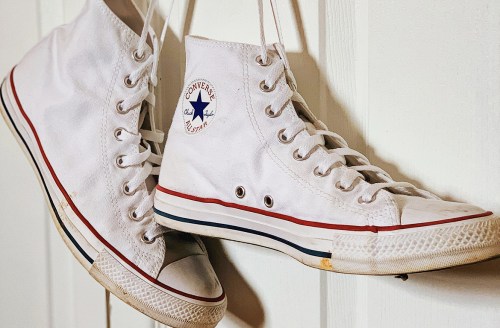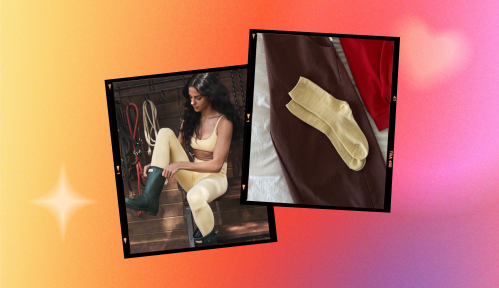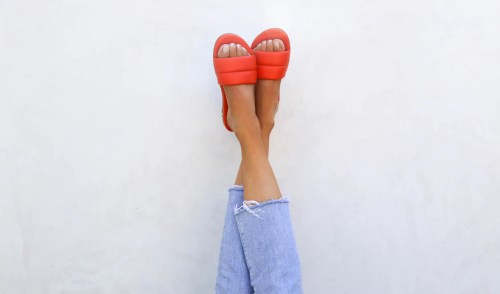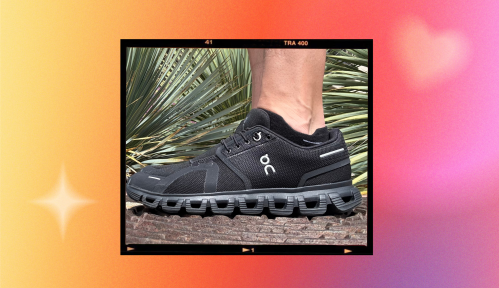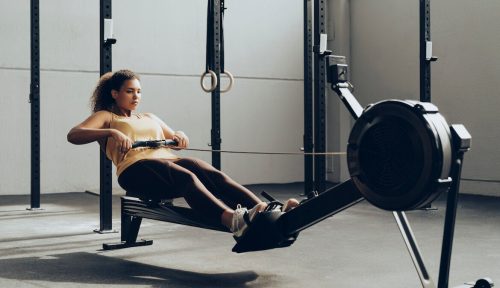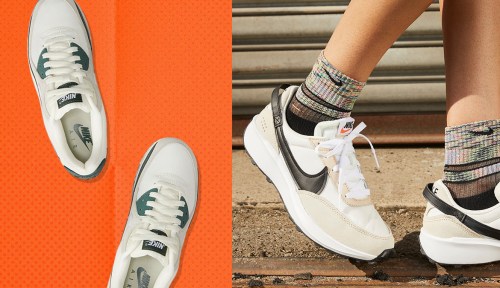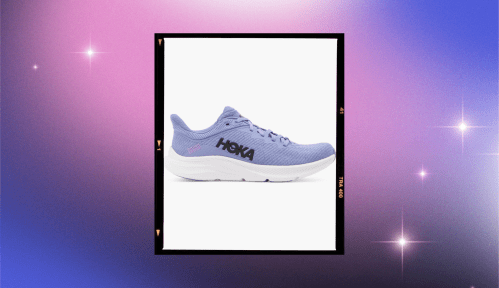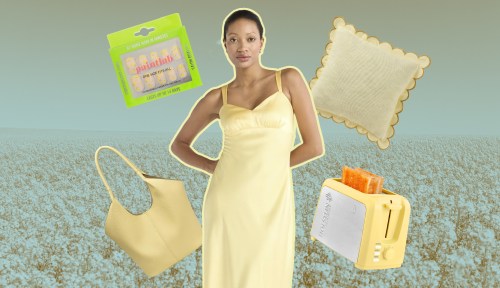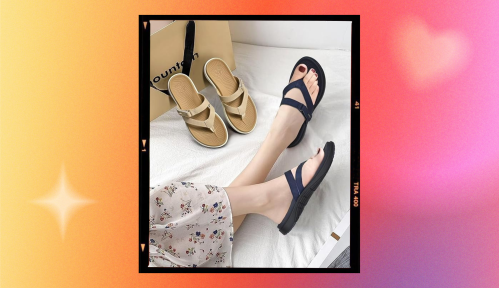Our editors independently select these products. Making a purchase through our links may earn Well+Good a commission
It’s no secret that Converse are the shoe of choice for avid gym-goers. Still, the controversy surrounding flat sneakers—which are often mistakenly thought to be the antithesis of a gym shoe solely based on looks—resurfaces every so often. Rather than regurgitating explanations about why to wear Converse for weightlifting, we chatted with ACE-certified personal trainer Chris Gagliardi (who happens to also be ACE’s Scientific Education Content Manager), as well as nationally renowned podiatrist Jackie Sutera, DPM (who is also a Vionic Innovation Lab Member), and Suzanne Levine, DPM, a podiatric foot surgeon and founder of Millennium Podiatry.
Experts in This Article
an ACE-certified personal trainer and NSCA-certified strength and conditioning specialist
podiatrist and member of the Vionic Innovation Lab
aesthetic podiatrist and podiatric foot surgeon
Ahead, learn why Chuck Taylor All Star sneakers are not just cute sneakers you can work out in, but the best choice for a lifting shoe, according to experts.
Why are Converse so great for weightlifting?
1. Improved Foot Position Awareness and Stability
According to Gagliardi, there are a few reasons why flat shoes like Converse are such great weightlifting shoes. For starters, “cushioned footwear, with increased softness and thickness of the sole material, may worsen foot position awareness1 and impair stability,” he says.
2. Better Ground Reaction Force
“Additionally, cushioned footwear may dissipate ground reaction forces,” Gagliardi says. “When you perform a squat, for example, you are pushing into the ground and the ground is providing an equal and opposite amount of force back to you (reduced transfer of force). The more cushioning you have the more force may be lost in the cushioning.”
3. Greater Toe and Foot Grip
What’s more, Sutera says that flatter, less-cushioned shoes allow better toe and foot grip, which lends to a more grounded lift. “[Flat shoes] are similar to when you are barefoot,” she says. “Gripping the ground while lifting creates stability and the feeling of being more planted to the ground.”
4. A More Challenging Workout
Beyond that, Gagliardi says that, from the most general perspective, the less support provided by the shoe, the more your own body has to work. As a result, wearing flat shoes like Chucks will force your proprioceptors and stabilizing muscles into action, which can lead to a stronger and more defined physique as a result.
5. Better for Back Support
Flat shoes, like Chucks, are also better for your back when weightlifting. “If your feet or shoes are flat, then you don’t have pelvic tilt, and the shearing forces are better distributed up the channel of the body, the ankles, knees, hips, and back,” Dr. Levine explains.
6. Gives Your Feet a Workout, Too
Fun fact: There are 38 intrinsic muscles in the foot, Dr. Levine says. And like the muscles in other parts of the body, they too need to be activated and working. Wearing Converse for lifting engages the foot so all those muscles are being strengthened as well.
Converse Sneakers Perfect for Weightlifting
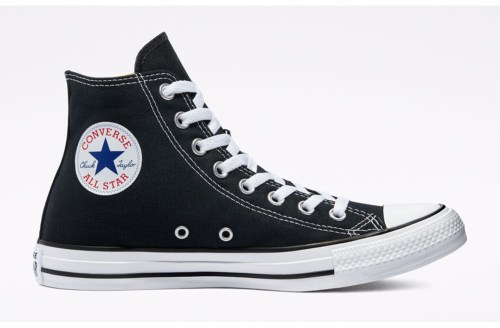
Converse, Chuck Taylor All Star Classic High Top — $65.00
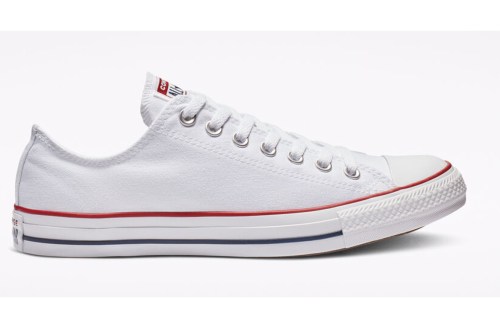
Converse, Chuck Taylor All Star Classic — $60.00
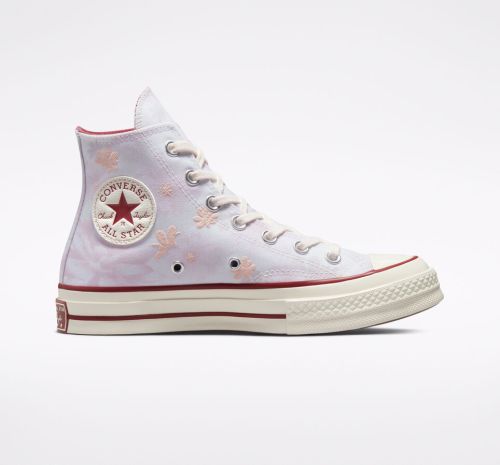
Converse, Chuck 70 Embroidered Desert Floral High Top — $85.00
Are there any disadvantages to wearing Converse for lifting?
While generally, Converse sneakers are good for weightlifting, there are some disadvantages to keep in mind. Dr. Levine notes that people with short heel cords (which is common among men, runners, and people over 50) have a greater chance of tears in that area. “With the excess weight and strain on a short heel cord, you can tear your Achilles heel,” she says.
Also, some people’s heel bones can also develop spurs. “With all the pressure on the longitudinal arch and the stress and strain on the heel, you can develop little bleeds that calcify,” Dr. Levine says. “These calcifications are heel spurs and they show up on x-rays.”
What kind of Converse are good for lifting?
As for what kind of Converse are best for lifting, Dr. Levine says you can’t go wrong with high top sneakers in particular. “High tops are great because they give extra ankle support,” she says. “They also have a wide toe box so that your foot can splay out with heavy weight bearing exercises.”
What to look for in a good weightlifting shoe
While Converse aren’t specifically designed for weightlifting, they work well for it thanks to their minimal cushioning. So as a general rule of thumb, Dr. Levine recommends avoiding shoes that have too much cushioning or are springy in the sole when doing deadlifts and squats in particular. “You want to have something solid to push and pull against,” she says. “If shoes are too cushioned you won’t be able to generate enough force.”
And, ensure the shoe provides even weight distribution and stability. “If the sole is too bendable, it will allow your foot to move around too much and cause a loss of stability,” Dr. Levine says.
Ultimately, “decisions about footwear should be based on how the footwear affects your movement patterns and your posture,” Gagliardi says. “The type of footwear you select may also change as your level of training experience changes. In addition, there is not one shoe that is best for everyone, and this means that you may need to experiment with different types and brands of shoes to find the style that offers the comfort and control that you need.”
Other Shoe Options for Lifting
That said, Converse are not the only shoes suitable for lifting. For some people, Converse will work great for squatting in particular, but for others it may not be the best option. Dr. Levine says this depends on your anatomy, specifically torso versus limb length. “People with longer torsos and shorter limbs will have different biomechanics than those with shorter torsos and longer legs,” she says. “You also have to take into account hip flexor and ankle mobility. If you are having a hard time adding depth to your squat, you might be better off using those shoes with a wedge because that changes ankle mobility so that you can get a little deeper.”
This begs the question: Is there any point in investing in lifting shoes? According to Dr. Levine, you can if you want to, of course, but it’s really not necessary. Specifically, she says people with plantar fasciitis (inflammation of the thick band of tissue that connects the heel bone to the toes) or Haglund’s heel (a bony enlargement on the back of the heel) may feel some benefits from investing in weightlifting shoes. Generally, solid, flat shoes like Converse fit the bill.
Should you ever lift weights in non-flat shoes?
According to Sutera, flat shoes are only truly necessary when working your lower body. “When lifting lighter weights, or doing more upper body work, it isn’t as beneficial to wear flat sneakers,” she says. “For these exercises your regular gym sneakers are adequate. It’s when you do lower body and heavier weights that the flat shoes can help you to grip better.”
That said, even when doing lower body exercises, Gagliardi says that 0.5 to 1-inch heels can be helpful.
“This heel lift may cause the knees to be in a more flexed position and upright posture during squatting,” he explains, noting that a slight heel can offer greater balance and support a better squatting form compared to completely flat soles.
The Takeaway
There is a best sneaker for every type of workout and Chuck Taylors have a place in the gym, but they’re best suited for more advanced lifters and/or those with a full range of motion, as they don’t assist the knees the way that slightly-cushioned weightlifting shoes do.
Squadrone, R, and C Gallozzi. “Effect of a five-toed minimal protection shoe on static and dynamic ankle position sense.” The Journal of sports medicine and physical fitness vol. 51,3 (2011): 401-8.
↩︎
Sign up for the Well+Good SHOP Newsletter
Get exclusive deals on wellness, beauty, fitness, and food products that have been hand-picked by our editors.
Got it, you've been added to our email list.
